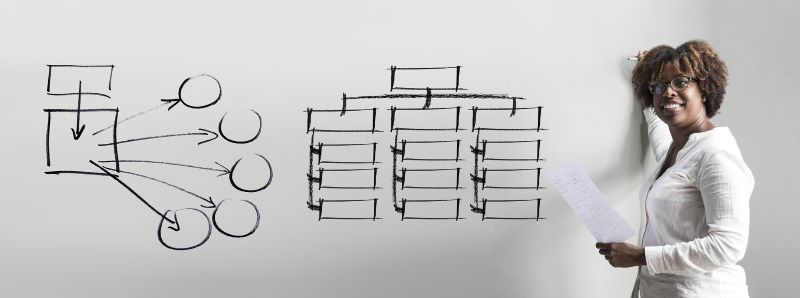Documenting processes is often seen as a tedious and unnecessary activity. « I know what I have to do ». It’ s true, but we don’t take the time to document for ourselves. It’s for others.

I’ve just started a new job and I realise that my colleague’s role is critical, and that only she can do it. She is what we call a “single point of failure”. If she quits the organisation or even leaves unexpectedly, then we can no longer operate. Whether it’s the login details for a supplier’s site, the unofficial method of restarting a recalcitrant machine or the name of the person who could help us, when my colleague is away, nothing works.
This disaster scenario is unfortunately all too common. Caught up in the flow of everyday life, we too often forget to document processes, making these points of failure even more critical.
Why should you document processes?
Firstly, for those who will take over the activity if the employee usually doing it is absent. Having the activity described step by step, with all relevant information, reduces the need for learning. In intellectual tasks, dexterity and habit often have less impact on the outcome. The person who replaces her colleague needs to understand the principle of the process and the objective. Details are documented and will be used when appropriate. You cannot always have at least two people trained on each activity. Many organizations are too small to afford this luxury. Taking the time to document significantly increases your resilience.
As part of a business continuity or recovery plan, process documentation simplifies the work. By knowing the steps in the process, it is easier to determine alternatives according to the scenarios. If I no longer have the Internet, what do I do? If I can no longer access the building, how can I do otherwise? The process as well as the continuity solutions are documented, which increases the resilience of the organization. It is ready to face the disruption and continue to operate.
Finally, documentation is the first step to improvement . Putting your ideas on paper helps to clarify them. Explaining to a colleague the steps followed reveals inconsistencies or duplicates. Your colleague will discuss the steps based on their knowledge of other processes. Her questions will force you to clarify your process and assess the relevance of the different steps.
How do you document processes?

There is no right answer. You need to find the solution that works for your organization.
Some prefer texts that describe the steps in sentences or numbered lists. Others swear by diagrams. Some software even offers to switch from one option to another. It’s a bit wobbly, because the text lacks words and the boxes are too busy in my opinion. I therefore invite you to decide and choose the option that best suits your field.
Different levels of process : Procedures, process, for me words don’t matter, what matters is the level of detail. In this article I talk about the lowest level: operational processes or procedures. The detailed steps that operators must follow to complete the tasks. I prefer the text to have the maximum of detail. On the other hand, when it comes to illustrating the high-level steps, to situate the activity, I prefer a diagram.
Once you have chosen between text or diagram, you must choose your medium: paper or digital. The digital format is easier to share, archive, update, as long as you have an effective solution and your users are trained. With digital solutions comes the need for standardization and documentation of the method for documenting processes. It can quickly become cumbersome, especially if your users don’t like the idea of documentation.
The goal is for the documentation to be useful. If the paper format is the most practical, go for it! Keep it simple. It will be enough to scan the procedure to share it. PowerPoint or Word are also two simple solutions for documenting. And a priori, everyone knows how to use it.
Let’s imagine… What do you choose?
Simple solution
- Documented in Word
- Text Format
- Some photos of hand drawings or screenshots
- File naming convention
- Well organized directory
- Document owner identified
- Updated less than a year ago
Optimal solution
- Documented in a SaaS tool
- Switch from text to diagram in one click
- Without pictures, because no one knows how to include them
- Structured according to the value chain, which make updating work complex, because several sectors are involved at different stages of each process
- Owners identified in the system
- No update despite reminder emails to owner
Technology can bring a lot, but I advise you to look for a more complete solution than pure process documentation. At the industrial level, the digital twin, which documents all the equipment, parameters and procedures, is a tool that will have a better chance of staying up to date, because it offers more value, even if the investment initial is more important. In the service sector, it is the measurement of the performance of the processes or simply the tool used to carry out the process which should be used to document.
Your action plan
Well, I convinced you, you convinced your colleagues, so here we go.
Step 1: Confirm why you are documenting the processes. I have given you several reasons, you may have others. Knowing why will guide you to the next phase, and help you stay on track when you run into difficulties.

Step 2: Specify the goal: when do you stop? Given the operational changes and all the exceptions and variations, you could spend your days documenting and never finish. To achieve your goal, what must you accomplish? 100% of processes documented in all departments? Only activities identified as critical in the impact analysis . You can also document the standard and leave exceptions aside. Set sub-goals and deadlines. By slicing the work , you have a better chance of success.
Step 3: Choose your tool and define your standards. If some rules are important: start each step with a verb, others are useless: capitalize all key words. Share responsibilities and set consistent update deadlines. A process that has not changed for 10 years can be reviewed in 2 years. Anyone who uses a tool that is updated every month should be reviewed every 6 months.
Step 4: let’s go. You can use a chart to help you track your progress. Don’t forget to celebrate each success. If you need help, I explain how to make a mapping.
Don’t forget… Before you start documenting, know why you are documenting. These reasons will influence the chosen methodology. And if you can’t think of a reason other than “you have to document, it’s important”, then forget about it… the time to understand why this process is important in your context.